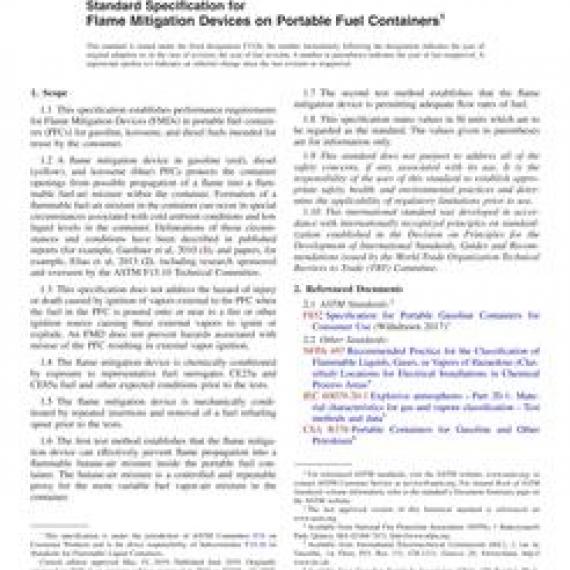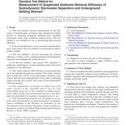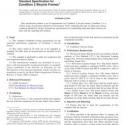No products
ASTM F3326-19a
ASTM F3326-19a Standard Specification for Flame Mitigation Devices on Portable Fuel Containers
standard by ASTM International, 05/15/2019
Full Description
1.1This specification establishes performance requirements for Flame Mitigation Devices (FMDs) in portable fuel containers (PFCs) for gasoline, kerosene, and diesel fuels intended for reuse by the consumer.
1.2A flame mitigation device in gasoline (red), diesel (yellow), and kerosene (blue) PFCs protects the container openings from possible propagation of a flame into a flammable fuel-air mixture within the container. Formation of a flammable fuel-air mixture in the container can occur in special circumstances associated with cold ambient conditions and low liquid levels in the container. Delineations of those circumstances and conditions have been described in published reports (for example, Gardiner et al, 2010 (1), and papers, for example, Elias et al, 2013 (2), including research sponsored and overseen by the ASTM F15.10 Technical Committee.
1.3This specification does not address the hazard of injury or death caused by ignition of vapors external to the PFC when the fuel in the PFC is poured onto or near to a fire or other ignition source causing these external vapors to ignite or explode. An FMD does not prevent hazards associated with misuse of the PFC resulting in external vapor ignition.
1.4The flame mitigation device is chemically conditioned by exposure to representative fuel surrogates CE25a and CE85a fuel and other expected conditions prior to the tests.
1.5The flame mitigation device is mechanically conditioned by repeated insertions and removal of a fuel refueling spout prior to the tests.
1.6The first test method establishes that the flame mitigation device can effectively prevent flame propagation into a flammable butane-air mixture inside the portable fuel container. The butane-air mixture is a controlled and repeatable proxy for the more variable fuel vapor-air mixture in the container.
1.7The second test method establishes that the flame mitigation device is permitting adequate flow rates of fuel.
1.8This specification states values in SI units which are to be regarded as the standard. The values given in parentheses are for information only.
1.9This standard does not purport to address all of the safety concerns, if any, associated with its use. It is the responsibility of the user of this standard to establish appropriate safety, health, and environmental practices and determine the applicability of regulatory limitations prior to use.
1.10This international standard was developed in accordance with internationally recognized principles on standardization established in the Decision on Principles for the Development of International Standards, Guides and Recommendations issued by the World Trade Organization Technical Barriers to Trade (TBT) Committee.


































